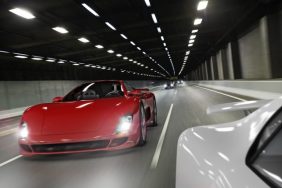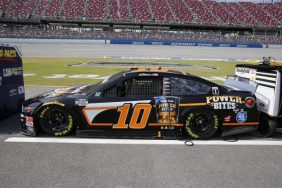
It’s a minor tragedy that some American sports fans never experience a NASCAR race.
Though its attendance numbers and weekly national television appearances make NASCAR one of this country’s dominant sports, there are football, baseball and basketball fans coast to coast who somehow don’t consider weekly racing pageantry to be a sporting event worth attending in person. They’re missing one of the most visceral and all-involving sensory experiences in all of human competition.
To get the word of racing’s appeal out to circles of potential fans yet untapped, NASCAR officials invited a mix of media to the 2013 Daytona 500 for a behind the scenes examination of the race, the garages, the pits, the fans and every other available aspect of one big noisy weekend on the Florida coast.
The Daytona 500 is unique in the national event spectrum. It’s the sport’s Super Bowl – the biggest single event on the NASCAR calendar – even though it’s also the sport’s annual kickoff. In racing terms, it ranks with the World Series, The Masters and Wimbledon in significance, but the 500 doesn’t decide any championship beyond its own trophy for this single race’s winner. Conquering its 500 miles ranks with a Sprint Cup win as the greatest achievement of a NASCAR driver’s career.
The 500 is the crowning moment of Daytona Speed Week, following days of truck races, a Nationwide Series race and Sprint Cup qualifying contests. This year, a total of more than 200,000 people crowd into the sprawling Daytona International Speedway for Sunday’s finale, the 55th running of the Great American Race.
Not Your Grandpa’s NASCAR
Preconceived notions of what a NASCAR race tumble faster than Tony Stewart’s lap times as you enter the track grounds. For the uninitiated, Formula 1 is usually considered the cultured, rich man’s racing tour. Even though NASCAR has better overall attendance figures and higher ratings in the U.S., Formula 1’s global racing schedule and high-tech cars give it an ambiance of wealth and sophistication.
Meanwhile, NASCAR – while eager to attract the everyman sports fan – is fighting off the tired, cliched image of stock car racing as a ham and egger’s passion. While stock cars share a 50+ year history of uncommon men racing common cars, the money and technology driving NASCAR today has left that country bumpkin concept a lap behind.
The infield of the Speedway during Speed Week sits full of massive, six figure campers and RVs with hardwood floors and marble counter tops surrounding king size beds. While football fans might set up a Weber Grill and roast some bratwurst, these race fans set up broad white tents, full service bars and mobile barbecue pits capable of roasting a whole pig on demand.
These well-heeled gearheads sit outside their RVs and watch the race on 72-inch big screen outdoor TVs powered by portable generators, while the live roar of stock car engines provides background noise. Once the winner crosses the finish line, the RV crews pack up their wares and head out onto the road – cruising to the next stop on the NASCAR tour.
After Daytona, a caravan of fan campers began the long cross-country trek to Phoenix. Those devotees might not be hopping from Monaco to Tokyo in the F1 world, but a week to week pursuit of the long NASCAR schedule and the race tour’s massive traveling circus of drivers, crews and support staff requires some serious scratch.

One Big, Loud Family
The image of that traveling circus is particularly well assigned – not because the NASCAR road show is stocked with clowns and animals, but because it’s a massive mobile family. A walk around the track reveals a mix of drivers, pit crew workers, mechanics, PR pros, media and support staff numbering into the thousands. Still, it quickly becomes clear that most of them know each other.
While scrambling between their various race day responsibilities, there’s always time for a “What’s up, y’all?” and a hug with a quick check in on how the family is doing back home. They’re people from distinct backgrounds with very different tasks to perform, but they are brought together and united by a love of racing.
That same atmosphere of friendliness and common bond spills over between the couple hundred thousand ticket buyers filling the speedway. Sure, you get your occasional drunken fool or mouthy jackass showing off to his friends. But, for the most part, NASCAR fans are friendly, polite and simply on site to enjoy themselves. Even if they can spot a yankee or a rookie fan from a country mile, they seem to roll with “live and let race.”
I was left to wonder if those in the prejudiced anti-racing crowd could be so welcoming. It’s the elitist snob who waves off the Daytona 500 crowd as redneck central, dismissing stock cars as lowbrow amusement – setting their effete selves somehow above the lovers of paint trading. I honestly can’t envision those racing fans passing such surly judgements in return.
Comfort Food for the Senses
Walking through the race grounds before a NASCAR race is not an experience for the delicate or sensitive soul. If all you can handle is the quiet rustle of a bored baseball stadium or even the on again, off again buzz of a football game, a race might be too much for your pampered ears. For the vitesse devotee, the visceral, sensual assault of race day is non-stop adrenaline.
You’re constantly awash in a boiling sea of noise. Revving engines rattle your chest cavity as mechanics fine tune the power plants to race trim. The high-pitched, stabbing whine of power drills tightening pre-glued tire nuts punctuates loudspeaker announcements and broadcast pre-race interviews.
Countless thousands with pit passes mull around race crews as they set up each car’s on-track HQs. With improved racing technology bringing cars closer together at top speeds – and with tenths of seconds separating winners from mere top 10 finishers, races can be won or lost by pit crews. A misstep that costs a team even a second or two in the pits can blow a victory.
With that in mind, the six man teams that go over the wall to service race cars are no longer bunches of grubby mechanics. Pit crew members are now predominantly recently graduated college athletes – young men in the peak of fitness afforded by years of football, baseball or track and field. They weight train on a daily basis with professional strength and conditioning coaches before heading to the various tracks a couple of days before the race.
All that work is worth it when you realize the men jumping over the wall in the NASCAR pits bring home salaries in the low six-figure range.
Crew chiefs watch the race on video monitors with a steady stream of track data flowing to their displays. They communicate with their respective drivers via radio headset as spotters high overhead atop speedway towers pipe in with track positioning data.

A View to a Lap
Out on the track, some of the best drivers on the planet make the most of skills enhanced since early in childhood. Starting young helps the professional racer eliminate fear from the DNA. When your mind might say “brake,” a pro drivers sees opportunity to pass. As Mario Andretti said, “If you’re not scared, you’re not going fast enough.”
I enjoyed a two-lap test run in an official pace car the morning of the 500 with NASCAR star Kevin Harvick behind the wheel. Though pushing speeds at double the average driver’s freeway velocity, the exhibition laps were a casual morning workout for Harvick. His #33 car pushes 200 mph on race days with more than 40 other cars during big oval runs like Daytona, so fan and media laps give him a chance for a little small talk – a bit of “How are you this morning…?” and “Is this your first Daytona 500…?” at 150 mph.
Harvick’s genuine friendliness is typical of how drivers look to interact with the public. NASCAR and its leading stars have always had the reputation for treating their fans well – for remembering that the tanned, in-denim’d folks in the grandstands are the reason cars turns laps every summer weekend.
Riding along in a banked oval like the Daytona track offers a perspective on what drivers must feel during competition laps. The steepest banking sits between the turns, leading into and away from the main straightaway and back stretch. Out of turn one and into turn two, the angling of the track folds the sensory world in on itself – eliminating peripheral vision and creating a sort of open tunnel effect. On the straights, the cars hug the safety walls to eliminate side drafting.
Any fool who looks at a NASCAR oval track race and describes it as boring because “all they do is turn left” should sit in on one of these experiential laps. Better yet, I’d love to see such a buffoon try to get a car around the oval just once at speed on their own – while imagining what the challenge must be like with, say, 42 other cars crowding within inches of each other.
High Octane, Low Pretense Partying
Pre-race pageantry is not for the politically correct or the non-patriotic. Some New York and LA-based members of my media were caught off-guard (and without a latte) when a Reverend offered the official pre-race blessing over the loudspeakers. In their pseudo-intellectual, skinny jeans world, religion has no place at a public event – unless they’re talking worshiping their own enlightened sensitivity or whatever politician they’ve sewn their lips to that month.
Fortunately, the more aghast, progressive members of our group had enough sense to keep their eyes open and their mouths shut.
Just when the delicate, bi-coastal types were catching their breath from the shock and awe of the pre-race prayer, the singing of our National Anthem arrived. Nearby track security didn’t hesitate to call loudly for all attendees to stand and for all hats to disappear. These directions were not suggestions. They were mandatory conditions for attendance.
Once the cars are off the starting grid and underway, the senses are tested by the rocket blast of passing engine noise and the streaking colors of passing sponsors. Whether proving their fandom mettle by taking it in without ear plugs or listening into track radios with headsets, all eyes in the grandstands follow the action on the lead laps.
On this day, the biggest crowd responses greeted fan favorite Danica Patrick’s brief retake of the lead following mid-race pitstops and fan villain Kyle Busch’s engine blowout later in the race.
After Jimmie Johnson’s spotless 48 car won him his second career Daytona 500 championship, the five-time Sprint Cup champion nearly wrecked his ride on the infield while doing victory burnouts. Fan response was decent, if lukewarm. As great a driver as Johnson is – and as well-spoken he is while representing NASCAR, there remains a sentiment amongst the fan base that he wins too often for drama to flourish. Basically, racing fans who love underdogs like Patrick are slower to embrace consistent winners like Johnson.
Once the race is over, a mix of exhausted satisfaction and sad resignation fills the Speedway. It’s time for the crews to pack up the cars, tools and gear into trucks for their long trip to the next race. It’s the moment when fans shuffle home with their special memories and a faint buzzing in the ears.
And, it’s time for journalists like me to embrace a respect for the unique stew of power, technology, skill, friendless and respect that flavors the NASCAR experience. I look forward to seeing it all again down the road.









